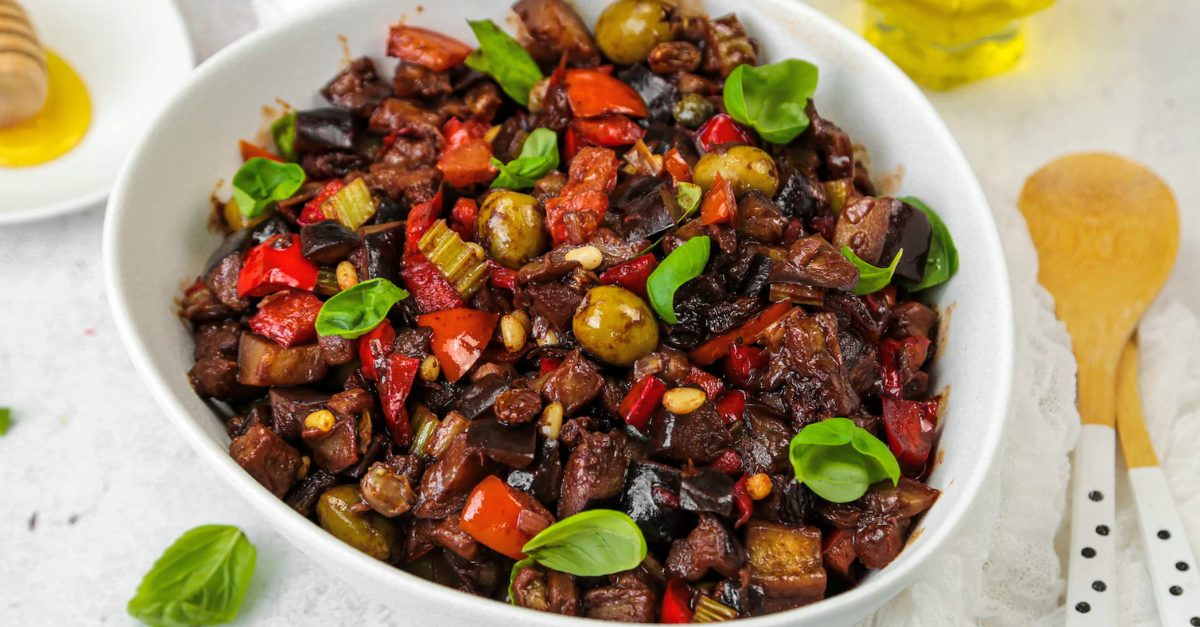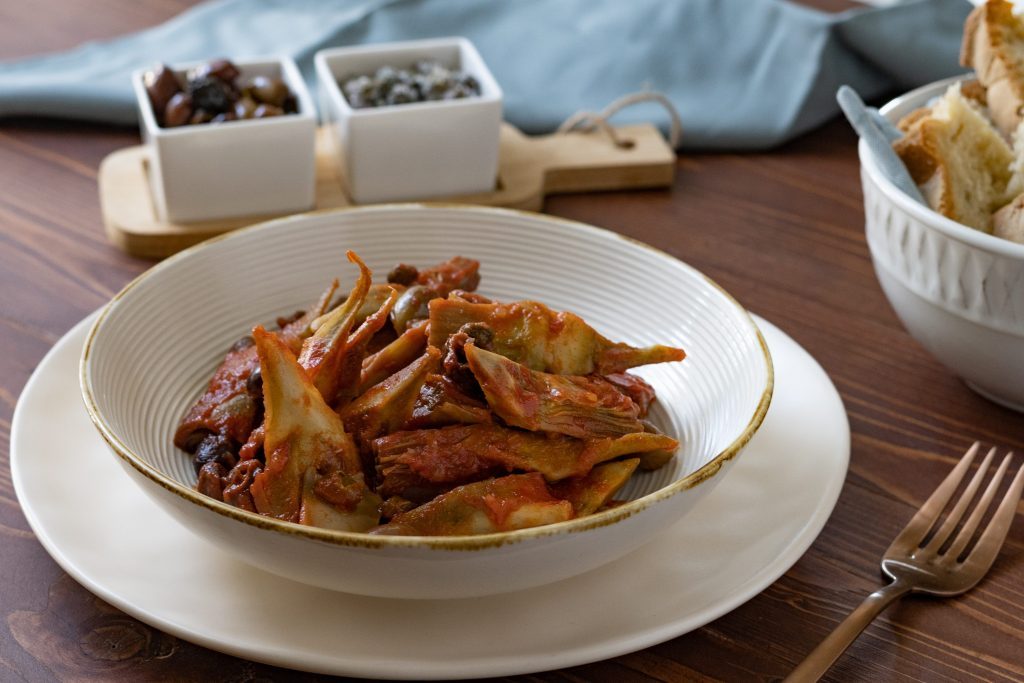Caponata: the vegetarian Sicilian side dish recipe for making sweet-sour eggplant caponata
;)
Ingredients
Caponata is a traditional, vegetarian Sicilian side dish recipe, perfect to enjoy during summer season. It is a sort of relish made of chopped fried eggplants, bell peppers, tomatoes, onions, celery, olives and capers flavored in a sauce which is sweet-sour or agrodolce as Italians say.
The secret ingredients are the wine vinegar and capers which add a tangy boost, while the cocoa powder, honey and raisins make this recipe sweet. Serve the caponata warm or at room temperature with any main course of meat or fish, or as an appetizer on a grilled toast, or bruschetta.
Like all traditional recipes, there are many different versions. Each area or family has its own recipe, there are those who add raisins, or tomato sauce, or those who replace sugar with honey or even cocoa powder as we did.
If you've never had the chance of trying caponata before, it's similar to the French ratatouille. Although caponata is simple to make, it's incredibly flavorful, and a great way to enjoy a healthy serving of veggies.
To allow the flavors to blend perfectly, it is best to make the caponata ahead of time and let it rest for several hours, even better overnight. If stored in the refrigerator, remember to take it out at least an hour before serving.
What is Eggplant Caponata?
Caponata (pronounced ka-puh-naa-tuh) is a traditional, vegetarian Sicilian dish noted for its fantastic agrodolce or sweet-sour flavor. Eggplants are the main ingredient of the dish, together with ripe tomatoes, tangy vinegar, and salty capers, and sweet raisins.
Because of its southern position on the Italian peninsula, the island of Sicily has been greatly influenced by other cultures over the centuries. Even the recipe for caponata is a result of these different cuisines coming together. Caponata took the sweet and sour flavor from the Arabs, the Mediterranean flavor given by the tomatoes from the Italians, and the melange of vegetables from Spain and France.
It is unclear why caponata is called this way since there are several legends about it. Among many, it is thought that the name comes from the word Capone, which in Sicilian dialect is associated with mahi-mahi, a type of fine fish that less wealthy people had begun to substitute for eggplant in their recipes. On the other hand, others believe that the term caponata comes from the Greek word capto meaning "cut," or even from the Latin word caupona, which stands for the ancient tavern where sailors used to meet.
Caponata vs. Ratatouille
While the two dishes are similar, they're both essentially vegetable stews, ratatouille hails from the south of France while caponata is Sicilian.
Ratatouille tends to include other vegetables like zucchini, carrot, bell pepper, and various herbs. Caponata has a sweet-sour flavor as it includes raisins and a sweetener such as honey, sugar or cocoa powder which there aren't in the ratatouille.
Tips for making Easy Caponata
In this recipe we fried the chopped eggplants, but you can also roast them in the oven at 400°F for about 20-30 minutes.
Olives make a great addition to this recipe, thanks to their salty-savory flavor. When you add them to your caponata, roughly chop a small handful of olives, and stir them in at the same stage you're mixing the capers, raisins, and celery into the dish.
What to serve with Italian Caponata
You can serve your eggplant caponata as a side dish together with a meat or fish main dish. You can also serve caponata as an appetizer by using it as a topping for a bruschetta or enjoying with a platter of cold cuts or cheese. You can also toss it with the pasta.
How to store Caponata
The caponata can be stored in the refrigerator for 2-3 days in an airtight container or covered with cling film. Before serving, let it rest at room temperature for at least 1 hour.
More Recipes You'll Like
How to make Caponata

Soak the raisins together with the marsala wine and capers for 30 minutes in cold water.
Soak the raisins together with the marsala wine and capers for 30 minutes in cold water.

Wash, dry and cut the ends of the eggplants, then divide them into slices and finally into cubes.
Wash, dry and cut the ends of the eggplants, then divide them into slices and finally into cubes.

Put them in a large colander and sprinkle them with a little salt. Let them rest for about 30 minutes so that they lose excess water.
Put them in a large colander and sprinkle them with a little salt. Let them rest for about 30 minutes so that they lose excess water.

Clean the celery, remove the toughest filaments and cut it into slices.
Clean the celery, remove the toughest filaments and cut it into slices.

Peel and chop the onion.
Peel and chop the onion.

Wash the pepper, divide it into layers and finally cut it into cubes.
Wash the pepper, divide it into layers and finally cut it into cubes.

In a pan, heat 3 tablespoons of extra virgin olive oil and fry the peppers for about 10 minutes.
In a pan, heat 3 tablespoons of extra virgin olive oil and fry the peppers for about 10 minutes.

In the same pan, add more oil and also fry the eggplants until they are cooked and slightly crunchy.
In the same pan, add more oil and also fry the eggplants until they are cooked and slightly crunchy.

Drain them on absorbent kitchen paper to remove excess grease.
Drain them on absorbent kitchen paper to remove excess grease.

In the same pan, sauté the celery with two tablespoons of oil.
In the same pan, sauté the celery with two tablespoons of oil.

Also add the onion and fry everything for 2 minutes.
Also add the onion and fry everything for 2 minutes.

Add the pine nuts and toast them for a few moments.
Add the pine nuts and toast them for a few moments.

Mix everything and also add the desalted capers.
Mix everything and also add the desalted capers.

Add the whole pitted olives and sauté everything for a few moments. Turn off the heat.
Add the whole pitted olives and sauté everything for a few moments. Turn off the heat.

Wash the cherry tomatoes, remove the seeds and cut them into cubes. Add them to the pan.
Wash the cherry tomatoes, remove the seeds and cut them into cubes. Add them to the pan.

Also add the previously cooked peppers.
Also add the previously cooked peppers.

And now also pour the eggplants, mix, season with salt and put them back over low heat.
And now also pour the eggplants, mix, season with salt and put them back over low heat.

In a small bowl pour 4 tablespoons of white wine vinegar, the tablespoon of honey and the unsweetened cocoa powder. Mix everything until you get a thick and smooth sauce.
In a small bowl pour 4 tablespoons of white wine vinegar, the tablespoon of honey and the unsweetened cocoa powder. Mix everything until you get a thick and smooth sauce.

Pour the prepared dressing over the vegetables, raise the heat and continue cooking for 3 minutes, stirring often so that the alcohol evaporates.
Pour the prepared dressing over the vegetables, raise the heat and continue cooking for 3 minutes, stirring often so that the alcohol evaporates.

Transfer the caponata to a large bowl, chop the fresh basil and add it to the caponata.
Transfer the caponata to a large bowl, chop the fresh basil and add it to the caponata.

Let it cool and then enjoy the caponata.
Let it cool and then enjoy the caponata.
;Resize,width=767;)
;Resize,width=712;)


